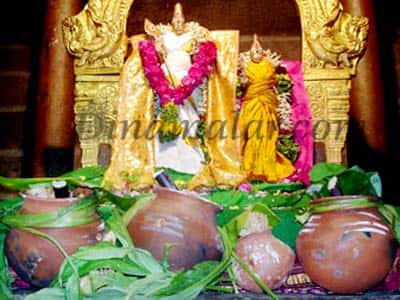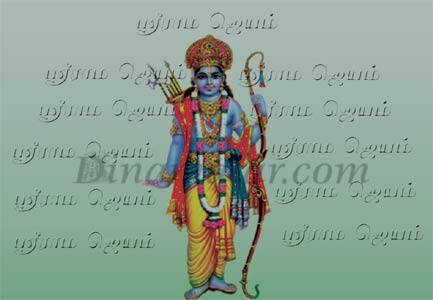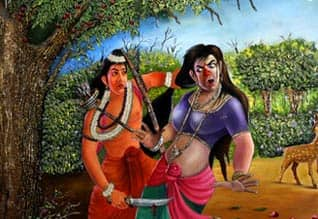பிரம்மிக்க வைக்கும் திருப்பதி அதிசியங்&#
பிரம்மிக்க வைக்கும் திருப்பதி அதிசியங்கள்..!!!!
திருப்பதி ஸ்ரீ ஏழுமலையான் திருவுருவச்சிலையில் சிலிர்க்க வைக்கும் ரகசியங்கள் உள்ளன
அவைகளில் சில.........
1. திருப்பதி ஆலயத்திலிருந்து 1 கிலோமீட்டர் தொலைவில் "சிலாதோரணம்" என்ற அபூர்வ பாறைகள் உள்ளன. உலகத்திலேயே இந்த பாறைகள் இங்கு மட்டும் தான் உள்ளன.இந்த பாறைகளின் வயது 250 கோடி வருடம். ஏழுமலையானின் திருமேனியும், இந்த பாறைகளும் ஒரே விதமானவை.
2. ஏழுமலையான் திருவுருவச்சிலைக்கு பச்சைக்கற்பூரம் சார்த்துகிறார்கள். இந்த பச்சைக்கற்பூரம் ஒரு இரசாயனம். அரிப்பைக் கொடுக்கும் ஒருவகை அமிலம். இந்த இரசாயனத்தை சாதாரணக்கருங்கல்லில் தடவினால் கருங்கல் வெடித்துவிடும். ஆனால், சிலாதாரணத்தில் உள்ள பாறைகளில் இதைத் தடவினால் அந்தப்பறைகள் பெடிப்பதில்லை. ஏழுமலையாக் திருவுருவச்சிலைக்கு 365 நாளும் பச்சைக்கற்பூரம் தடவுகிறார்கள். ஆனாலும்வெடிப்புஏற்படுவதில்லை.
3. எந்தக் கருங்கல் சிலையானாலும் எங்காவது ஒர் இடத்தில் சிற்பியின் உளிபட்டிருக்கும் இடம் தெரியும்.. உலோகச்சிலையானாலும் உலோ கத்தை உருக்கி வார்த்த இடம் தெரியும். ஏழுமலையான் திருவுருவச்சிலையில் அப்படி எதுவும் அடையாளம் தெரியவில்லை. எந்த கருங்கல் சிலையை எடுத்துக்கொண்டாலும் சுரசுரப்பாக இருக்கும். ஆனால் ஏழுமலையான் திருமேனியில் நுணுக்க வேலைப்பாடுகள் எல்லாம் மெருகு போடப்பட்டது போல் இருக்கின்றன. ஏழுமலையான் விக்ரகத்தில் நெற்றிச்சுட்டி, காதணிகள், புருவங்கள், நாகாபரணங்கள் எல்லாம் நகைக்கு பாலீஷ் போட்டது போல் பளபளப்பாகஇருக்கின்றன.
4. ஏழுமலையான் திருவுருவச்சிலை எப்போதும் 110 டிகிரி ஃபாரன்கீட் வெப்பத்தில் இருக்கிறது. திருமலை 3000 அடி உயரத்தில் உள்ள குளிர்பிரதேசம். அதிகாலை 4.30 மணிக்கு குளிர்ந்த நீர், பால் மற்றும் திரவியங்களால் அபிஷேகம் செய்கிறார்கள். ஆனால், அபிஷேகம் முடிந்தவுடன் ஏழுமலையானுக்கு வியர்க்கிறது.பீதாம்பரத்தால் வியர்வையை ஒற்றி எடுக்கிறார்கள். வியாழக்கிழமை அபிஷேகத்திற்கு முன்னதாக, நகைகளைக் கழற்றும் போது, ஆபரணங்கள் எல்லாம் சூடாகக்கொதிக்கின்றன.
திருப்பதி ஆலயம், அதன் வழிபாடு, உண்டியல் வசூல், பூஜை முறைகள், சரித்திர சம்பவங்கள் அனைத்தும் அதிசய நிகழ்வுகளாகஇருக்கின்றன.
1. திருப்பதி திருக்கோயில் சமையல்கட்டு மிககூம் பெரியதாகும். பொங்கல், தயிர்சாதம்,புளிச்சாதம், சித்ரான்னம், வடை, முறுக்கு, ஜிலேபி, அதி ரசம், போளி, அப்பம், மெளகாரம், லட்டு, பாயசம், தோசை, ரவாகேசரி, பாதாம்கேசரி, முந்திரிப்பருப்பு கேசரி போன்றவை தினமும் பெரிய அளவில் தயார் செய்யப்படுகின்றன.
2. ஏழுமலையானுக்கு தினமும் ஒரு புதிய மண்சட்டி வாங்குகிறார்கள். இதில் தயிர்சாதம் தவிர வேறு எந்த நைவேத்தியமும் கோவில் கர்பக்கிருகத்திற்குக் குலசேகரப் படியைத் தாண்டாது. வைரம், வைடூரியம், தங்கப்பாத்திரங்கள் எதுவும் குலசேகரப்படியைத் தாண்டச் செல்லாது. ஆண்டவனுக்கு நைவேத்தியம் செய்யப்பட்ட எச்சில் மண்சட்டியும், தயிர்சாதமும் ஒரு பக்தனுக்குக் கிடைக்கப் பெற்றால் அது மிகப்பெரிய பாக்கியமாகும்.
3. ஏழுமலையான் உடை 21 முழ நீளமும் 6 கிலோ எடையும் கொண்ட புடவை பட்டு பீதாம்பரமாகும். இந்த ஆடையை கடையில் வாங்க முடியாது. திருப்பதி தேவஸ்தான அலுவலகத்தில் 12500 ரூபாய் செலுத்த வேண்டும்.வாரத்தில் ஒரு முறை வெள்ளிக்கிழமை அன்று மட்டும் தான் வஸ்திரம் சாத்துவார்கள். இது மேல் சாத்து வஸ்திரம். பணம் செலுத்திய பிறகு வஸ்திரம் சாத்துவதற்கு மூன்று வருடங்கள் காத்திருக்க வேண்டும்.
4. உள் சாத்து வஸ்திரம் ஒரு செட் இருபதாயிரம் ரூபாய் கட்டணமாகும்.ஒவ்வொரு வெள்ளிக்கிழமையும் 15 வஸ்திரங்கள் சார்த்துவதற்கு சமர்ப்பிக்கப்படும். பணம் செலுத்திய பிறகு வஸ்திரம் சாத்துவதற்கு பத்து வருடங்கள் காத்திருக்க வேண்டும்.
5. பக்தர்கள் சமர்பிக்கும் வஸ்திரங்கள் தவிர அரசாங்கம் சமர்பிக்கும் சீர் வஸ்திரங்கள் ஆண்டுக்கு இரண்டு முறை சாத்தப்படுகிறது.
6. ஏழுமலை ஆண்டவனுக்கு அபிஷேகம் செய்ய இன்று கட்டணம் செலுத்தினால் மூன்று ஆண்டுகள் காத்திருக்க வேண்டும்.
7. அபிஷேகத்திற்காக ஸ்பெயினில் இருந்து குங்குமப்பூ, நேபாளத்திலிருந்து கஸ்தூரி, சைனாவிலிருந்து புனுகு, பாரிஸ் நகரத்திலிருந்து வாசனை திரவியங்கள் முதலிய உயர்ந்த பொருட்கள் வரவழைக்கப்பட்டு, தங்கத்தாம்பாளத்தில் சந்தனத்தோடு கரைக்கப்படும் 51 வட்டில் பால் அபிஷேகம் செய்யப்படும். பிறகு கஸ்தூரி சாத்தி, புனுகு தடவப்படும், காலை 4,30 மணி முதல் 5,30 மணி வரை அபிஷேகம் நடைபெறுகிறது. அபிஷேகத்திற்கு சுமார் ஒரு லட்ச ரூபாய் செலவு ஆகும்.
8. ஐரோப்பாவில் உள்ள ஆம்ஸ்டர்டாமில் இருந்து பக்குவப்படுத்தப்பட்ட ரோஜா மலர்கள் பக்தர்களால் திருப்பதிக்கு விமானத்தில் அனப்பி வைக்கப்படுகின்றன. ஒரு ரோஜா மலரின் விலைசுமார்80ரூபாய்.
9. சீனாவிலிருந்து சீனச்சூடம், அகில், சந்தனம், அம்பர், தக்கோலம், இலவங்கம், குங்குமம், தமாலம், நிரியாசம் போன்ற வாசனைப் பொருட்கள் ஏழுமலையான் திருக்கோயிலுக்காக அனுப்பப்படுகின்றன.
10. ஏழுமலையானின் நகைகளின் மதிப்பு ரூ.1000 கோடி, இவருயை நகைகளை வைத்துக்கொள்ள இடம் இடமும் இல்லை. சாத்துவதற்கு நேரமும் இல்லை. அதனால் ஆண்டிற்கு ஒரு முறை உபரியாக உள்ள நகைகளை செய்தித்தாட்களில் விளம்பரப்படுத்தி ஏலம் விடுகிறார்கள்.
11. ஏழுமலையானின் சாளக்கிராம தங்கமாலை 12கிலோ எடை. இதை சாத்துவதற்கு மூன்று அர்ச்சகர்கள் தேவை. சூரிய கடாரி 5 கிலோ எடை. பாதக்கவசம் 375 கிலோ. கோவிலில் இருக்கும் ஒற்றைக்கல் நீலம் உலகில் யாரிடமும் கிடையாது. இதன் மதிப்பு ரூ.100கோடி.
12. மாமன்னர்களான இராசேந்திர சோழர், கிருஷ்ண தேவராயர், அச்சதராயர் போன்றோர் .ஏழுமலையானுக்கு பல காணிக்கைகளையும், அறக்கட்டளைகளையும் செய்து அவற்றை கல்வெட்டுகளிலும், செப்பேடுகளிலும் பொறித்துள்ளனர். சோழ அரசியும் இங்கு வந்து காணிக்கை சமர்பித்து இருக்கிறார்.
13. ஆஜானுபாகுவாக இருக்கும் மூலவர் ஏழுமலை ஆண்டவனைப்போலவே, அபிஷேக அலங்காரம் செய்து பார்க்க ஒரு சிறிய விக்கிரகம் கி.பி.966 ஜுன் 8ஆம் தேதி வெள்ளியால் செய்யப்பட்டது. இந்த விக்ரகத்திற்கு பல்லவ குறுநில மன்னன் சக்தி விடங்கனின் பட்டத்து அரசி காடவன் பெருந்தேவி நகைகளைத்தந்து, பூஜைக்கு அறக்கட்டளையும் வைத்தார். முதலாம் குலோத்துங்க சோழன் திருமலை தேடிவந்து காணிக்கைசெலுத்திஉள்ளார்.
14. திருப்பதி ஓவியங்கள் 300 ஆண்டுகள் பழமையானவை.
15. வெள்ளிக்கிழமைகளில் வில்வ இலை அர்ச்சனைக்கு உபயோகப்படுத்தப்படுகிறது. மார்கழிமாத அர்சனைக்கும் உபயோகப்படுத்தப்படுகிறது.
16. சிவராத்திரி அன்று க்ஷேத்ர பாலிகா என்ற உற்சவம் நடைபெறுகிறது. அன்று உற்சவப்பெருமானுக்கு வைரத்தில் விபூதி நெற்றிப்படடை சாத்தப்பட்டு திருவீதி உலா நடைபெருகிறது. தாளப்பாக்கம் அன்னமய்யா, ஏழுமலையானை பரப்பிரம்மமாகவும், சிவாம்சம் பொருந்திய ஈஸ்வரனாகவும், சக்தி ஸ்வரூபமாகவும் பாடி, அந்த பாடல்களை செப்பேடுகளில் எழுதிவைத்துள்ளார். திருப்புகழ் பாடிய அருணகிரிநாதப் பெருமான் திருப்பதிக்கோயிலுக்கு வந்திருக்கிறார். அவரும் அன்னமய்யாவும் சமகாலத்தவர்கள். சங்கீத மும்மூர்த்திகளில் ஒருவரான முத்துசாமி தீட்சிதர் சிறந்த வித்யா உபாசகர், மந்திர சாஸ்திரம் தெரிந்தவர், நூற்றுக்கணக்கான தெய்வங்கள் மீது பாடியுள்ளார். ஏழுமயைான் மீது சேஷசல நாமம் வராளி ராகத்தில் பாடியுள்ளார்.
17. அபிஷேகத்தின் போது ஏழுமலையான் தனது மூன்றாவது கண்ணை திறக்கிறார் என்ற ஐதீகம் உள்ளது.
18. ஏழுமலையானின் ஸ்தல விருட்க்ஷம் புளிய மரம்.
19. எந்த சாத்வீக, சாந்தமான தெய்வத்தின் திருவுருவச்சிலையிலும் கையில் ஒரு ஆயுதமாகிலும் இருக்கும். ஆனால் ஏழுமலையான் திருவுருவச்சலையில் எந்த ஆயுதமும் கிடையாது. அவர் நிராயுதபாணி. அதனால்தான் தமிழ் இலக்கியத்தில் நம் முன்னோர்களால், வெறுங்கை வேடன் என்று அழைக்கப்பட்டார்.
20. 1781 ஆம் ஆண்டு பிரிட்டிஷ் பீரங்கிப்படை தக்கோலம் என்ற இடத்தில் முகாமிட்டிருந்தது. அப்படையின் 33 ஆவது பிரிவைச்சேர்ந்த லெவெல்லியன் என்ற போர் வீரர் படுகாயம் அடைந்தார். அவர் குணமடைய ஏழுமலையானை பிராத்தித்திருகிறார். குணமடைந்ததும் ஓர் இந்து சிப்பாய் மூலம் நேர்த்திக்கடன்செலுத்தியிருக்கிறார்.
21. ஆங்கிலேயர்கள் சர் தாமஸ் மன்றோ, கர்னல் ஜியோ ஸ்டிராட்டன் போன்றவர்கள் ஏழுமலையானின் பக்தர்கள் ஆவர்.
22. திருமலையின் புனிதத்தன்மை கருதி 1759 முதல் 1874 வரை எந்த ஆங்கிலேயரும் மலை ஏறவில்லை. ஆங்கிலப்பாதிரிகள் மலையில் ஏதாவது ஒரு பகுதியில் ஒரு சிலுவை நட விரும்பினார்கள். ஆனால் அதற்கு ஆங்கிலேயத் தளபதிகளே அனுமதி அளிக்கவில்லை. திருமலை திருக்கோயிலில் நித்யபடி பூஜைகள் நடக்க வேண்டும் என்று ஆங்கிலேயர்கள் விரும்பினார்கள். பூஜைகள் சரிவர நடக்காவிட்டால் தங்கள் ஆட்சிக்கு பங்கம் வரும் எனக் கவலைப்பட்டார்கள்.
23. திருப்பதி அலமேல்மங்கைக்கு உள்பாவாடை கத்வால் என்ற ஊரில் பருத்தியில் தயார் செய்யப்படுகிறது. செஞ்சு இனத்தைச்சேர்ந்த நெசவாளர்கள் இதை பயபக்தியுடன் நெய்கிறார்கள். உள் பாவாடை சீமாட்டியின் திருமேனியில் படுவதால், இதை நெய்யும் போது நெசவாளர்கள் மூன்று வேளை குளிப்பார்கள். அவர்கள் மது, மாமிசம் உண்ணமாட்டார்கள். வெள்ளிக்கிழமை அபிஷேகத்திந்கு பரிமள அறையில் வியாழன் இரவு அறைத்து தயார் செய்யப்படுகிறது. குங்குமப்பூ கலவையும் அபிஷேகத்திக்கு சேர்கப்படுகிறது. வெளிநாடுகளிலிருந்து வாசனை திரவியங்கள் பக்தர்கள் அனுப்பிய வண்ணம் உள்ளனர். ஒரு வாரத்திற்கு ரூ,50000 மதிப்புள்ள வாசனை திரவியங்கள் வருகின்றன.
24. ஏழுமலையான் வாரத்தில் நான்கு நாட்கள் அம்பாளாகவும், 2 நாட்கள் விஷ்னுவாகவும், ஒரு நாள் சிவனாகவும் கருதப்பட்டு பூஜை நடைபெற்று வந்துள்ளது.
25. ஏழுமலையானின் அபிஷேக நீர் குழாய் மூலம் புஷ்கரணியில் கலக்கிறது. ஆகவே இது புனிதமான நீராகும். இங்கே குளித்துவிட்டு நீரில் நின்ற படியே இரு கைகளாலும் தண்ணீரை எடுத்து குளத்திலேயே விடவேண்டும். இது விசேஷ வழிபாடாகும்.
25. வெள்ளிக்கிழமை அதிகாலை அபிஷேகத்திற்கு முன்பு ஒரு விசேஷ சாத்து முறை நடக்கும்.வடகலை சம்பிரதாயத்தில் '' வேங்கடமெனப்பெற்ற" என்ற பாசுரமும், தனியன்களும் இடம் பெறும். சாத்துமுறையின் போது பூ, வஸ்திரம் இல்லாமல் ஏழுமலையான் திருமேனியுடன் இருப்பார். முதலில் ஒரு தீபாராதனை எடுக்கப்படும். பிறகு தென் கலை சாத்து முறை சேவிக்கப்படும். பிறகு நைவேத்தியம் செய்யப்படும். பிறகு ஒரு தீபாராதனை செய்யப்படும். ஏழுமலையான் அந்த தீப ஒளியில் கண்ணைப் பறிக்கும் அழகோடு இருப்பார்.
26. கி.பி.1543ல் விஜயநகர மாமன்னர் அச்சுதராயர் பத்மாவதிதாயாருக்கு திருக்கோயில் எழுப்பி கும்பாபிஷேகம் செய்துள்ளார். கி.பி.1764ல் நிஜாம் தெளலா என்பவனின் தலைமையில் வந்த முஸ்லீம் படைகளால் இடித்து தரைமட்டமாக்கப்பட்டன. இதன் இடிபாடுகள் இன்றைக்கும் உள்ளன.
27. திருவில்லிப்புத்தூர் கோவிலில் இருந்து ஸ்ரீ ஆண்டாள் அணிந்த மாலைகள் திருபதி கொண்டு வரப்பட்டு ஏழுமலை ஆண்டவனுக்கு சாத்தப்படுகிறது. ஸ்ரீ ஆண்டாள் ஏழுமலையானை கடவுளாக வழிபட்டு வாழ்த்தி வணங்கிணார்.
28. திருமலை திருக்கோவிலில் 1180 கல்வெட்டுக்கள் உள்ளன. இதில் 236 பல்லவ, சோழ, பாண்டியர் காலத்தவை. 169 கல்வெட்டுக்கள் சாளுவ வம்ச மன்னர்கள் காலத்தவை. 229 கிருஷ்ண தேவராயர் காலத்தவை. 251 அச்சுதராயர் காலத்தவை. 147 சதாசிவராயர் காலத்தவை. 135 கொண்டை வீடு அரசர் காலத்தவை. நந்திவர்மன் (பல்லவர்) ஆண்ட கி.பி.830 தொடங்கி 1909 வரை உள்ளன. கல்வெட்டுகளில் 50 கல்வெட்டுக்கள் தான் தெலுங்கு, கன்னட மொழிகளில் உள்ளன. மீதம் 1130 கல்வெட்டுக்கள் தமிழில் தான் உள்ளன.!!!
Source:
தமிழ் தந்த சித்தர்கள்'







